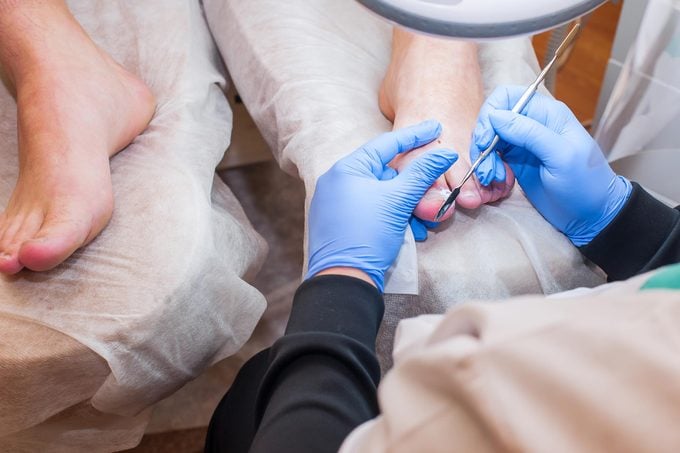How to Treat Toenail Fungus, According to a Podiatrist
Updated: Apr. 29, 2021
Toenail fungus treatments include the simple, the weird and wacky, and the high tech. See what a podiatrist recommends.
What is toenail fungus?
Toenail fungus (onychomycosis) is caused by a group of fungi known as dermophytes. This group thrives on skin and on keratin, the main component of hair and nails. The fungus gets under the nail and begins to grow, damaging the nail so it discolors, becoming white, brown, or yellow. Eventually, the nail might thicken, harden, become brittle, and even fall off.
According to the American Podiatric Medical Association, nail fungus is easy to pick up from showers, locker rooms, and swimming pools because fungi thrive in the damp, humid conditions. People with underlying health conditions like diabetes, circulatory issues, or immune-deficiency conditions are especially vulnerable, as are elderly people.
This condition can be very difficult to cure. Toenail fungus treatment often lasts for several weeks or months, but if you want to know how to get rid of toenail fungus, podiatrists have a clear strategy.
Take a full medical history
“The first step is to take a history of the problem,” says podiatrist Mark Hinkes, DPM, CEO of Healthy Feet in Nashville, Tennessee. “In other words, I want to know how long have you had this and what previous treatment you’ve had.” A podiatrist needs to understand the extent of the problem and any other medical factors which may influence their choice of toenail fungus treatment.
A full medical history is also important because the first line of defense is usually oral medication, but this treatment can have side effects for people with underlying health issues. Make sure you reveal everything—here are 14 things to never lie to your doctor about.
Physical exam
Once he’s got a medical history, Dr. Hinkes moves on to a physical exam. “A physical exam determines the quality,” he explains. “What does it look like? Is it thick? Does it smell? What color is it? Is it flaky? Is it on the tip of the nail? Is it at the base of the nail? And what color is it? Is it white? Is it superficial? Is it yellow, green, black?” Learn more about what your nail color says about your health.

Lab analysis
“We really cannot make a diagnosis by looking at the toenail,” Dr. Hinkes says. “It’s difficult to know whether it’s an infection of fungus, mold, or yeast. You must harvest a sample of the nail and send it to pathology.”
That’s the only way to ascertain exactly what the problem is so the podiatrist can prescribe the best course of action for toenail fungus treatment. Once the exact cause of the problem is identified, the podiatrist can then decide how to get rid of toenail fungus in the patient. Not all experts agree that lab tests are the way to go. Talk to your doctor about your options.
(Here are the different types of toenail fungus and how to treat them.)
Oral treatments
Oral anti-fungal treatments such as Lamisil (terbinafine), Diflucan (fluconazole) or Sporanox (itraconazole) are effective options and take around three months to work. However, they can have unpleasant side effects, including stomach upset, dizziness, skin problems, and liver damage leading to jaundice. This is why taking a full medical history is essential. Here’s some advice from doctors and nurses on coming clean about your medical history.
“The medications we use to treat this are expensive and they are not benign,” cautions Dr. Hinkes. “Lamisil is so powerful it stays in your body six months after you stop using it, and that’s one of the reasons why it works so well. So when we use these medicines, we have to be conscious that we may be affecting a person’s liver, because the liver is the organ that helps to detoxify the body and excretes that medicine.”
People with liver problems or raised liver function can’t tolerate oral medication, and some patients don’t respond to oral medication, so topical treatments are an alternative.

Topical treatments
Topical treatments are applied directly to the infected nail but may take a long time to work and are not always effective, especially if a large part of the nail is involved. For example, the toenail fungus treatment Kerydin can take up to 12 months to clear the condition. But they’re much more suitable for those with liver problems or who haven’t responded to oral treatments.
“Not every medicine works great for every person,” Dr. Hinkes says. “If someone was treated with the oral medicine and it didn’t have a success, there’s an alternative. We have good topical medicines that work great.”
Laser treatment
Laser treatment for this condition is offered by many podiatrists as it’s non-invasive and works quite quickly. The laser can attack the fungus beneath the nail, killing it off without damaging the nail itself.
Many podiatrists now consider this an effective treatment, but the clinical data is still emerging. According to a 2017 review of the research in the journal Dermatologic Surgery, studies of Q-switched Nd:YAG lasers with very short pulse durations and fractionated CO2 demonstrate the most promise for laser treatment of nail fungus.
Dr. Hinkes raises this concern: “A clinical cure and a mycological cure are two different things,” he says. “With the clinical cure, you look at the nail and it looks fine. It’s pink and shiny and smooth and it looks great. But if you sample the nail, you might find that there’s mold or fungus there, so it does not have what we call a mycological cure—mycology is the study of fungi.” In other words, your nail might look good, but there could still be fungus, yeast, or mold after the treatment, making it more likely that the infection will return. Make sure you know the 10 subtle signs of disease that your feet can reveal.
Surgical treatments
Modern treatments made surgery a last resort. “Before we had these 21st-century medications, we didn’t have a good choice in how to deal with toenail fungus,” says Dr. Hinkes. “Oftentimes, patients would come in, and out of frustration and lack of any real significant clinical cure with medication, they would ask for their nails to be permanently removed.”
Sometimes the whole nail can be removed and a healthy nail can grow in its place. But if the infection has gotten into the nail matrix, where the new nail is formed, the new nail will also be infected. In cases like this, it may be necessary to remove the matrix. This can be done with chemicals such as phenol or sodium hydroxide.
“Application of those chemicals would destroy the matrix cells,” explains Dr. Hinkes. After surgery, the toenail won’t grow back. “The other method,” he adds, “which is also very frequently used, is to surgically, sharply, cut out the matrix cells. And when that happens, you get a couple of stitches to the base of the area and that’s the end of it.”

Home remedies
Because the treatment for this condition doesn’t always work and can cause side effects, many people look to home remedies as a first step when trying to figure out how to get rid of toenail fungus.
Essential oils and ozonized oils
Tea tree oil has anti-fungal and antiseptic properties. The National Center for Complementary and Integrative Health cites some small-scale clinical studies suggesting that tea tree oil might be an effective home remedy for toenail fungus. Plus, these are the best essential oils for combating foot odor.
Oils such as olive oil and sunflower oil contain ozone gas. A small study published in the Brazilian Journal of Microbiology in 2011 showed that small doses of this kind of ozone, applied over a short period, can eliminate fungus in rabbits. A different study, conducted at the National Center for Scientific Research, Cuba, found that sunflower oil was more effective than the prescription drug Xolegel (ketoconazole) in treating foot fungus.
Plant extracts
Snakeroot extract comes from a plant in the sunflower family. A 2008 study published in Planta Medica, found that applying the extract to the affected nail over three months was more effective than treatment with the prescription anti-fungal Penlac (ciclopirox).
Weird and wacky
Most people have heard of using Vicks VapoRub for a cold, but the camphor and eucalyptus oil in the rub are also effective as a toenail fungus treatment. A small study published in 2011 in the Journal of the American Board of Family Medicine showed that applying Vicks VapoRub regularly could be effective in getting rid of nail fungus.
Another popular home toenail fungus treatment is to use Listerine mouthwash on its own or mixed with an equal amount of white vinegar. You can also try these foot soaks for toenail fungus.
The podiatrist’s take on home remedies
While home remedies are unlikely to cause any harm in themselves, Dr. Hinkes urges caution when relying on them when looking for how to get rid of toenail fungus.
“Resorting to folk remedies can be dangerous because it could keep the patient from getting a legitimate diagnosis and treatment,” he says. “Now in some people, this could be a critical thing, because it can be contagious—you can pass it to other people and you can pass it to other parts of your body. So it’s really not something you want to fool with.”
Dr. Hinkes’ advice is clear: Visit a foot care specialist. This could be a podiatrist, but foot care nurses also offer an excellent and affordable service as an alternative. And if neither of those is available, try a dermatologist. Your family care practitioner can also identify and treat many fungal conditions.
Left untreated, this condition won’t go away on its own and can cause serious pain, deformity, and even lead to further complications. Podiatrists recommend seeking expert help—you’re better safe than sorry. If you’re desperate, though, try these DIY foot and toenail fungus treatments.

